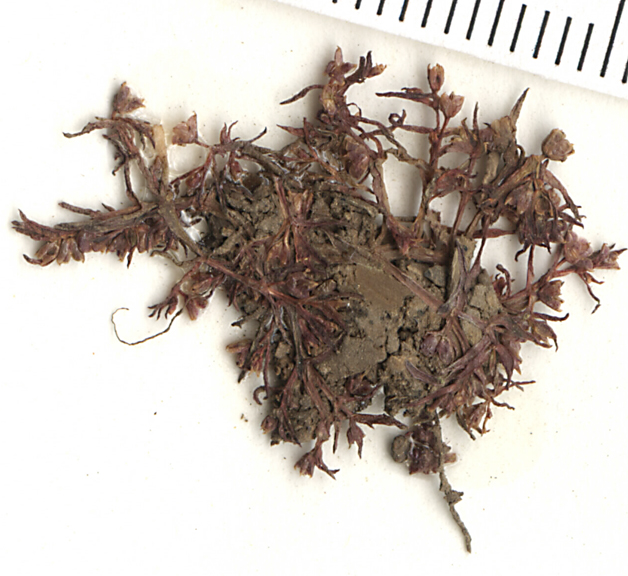Crassula
|
Family: Crassulaceae |
Herbs [shrubs], annual or perennial, aquatic or terrestrial, not viviparous, 0.1-5 dm, glabrous [pubescent]. Stems erect, decumbent, or spreading, simple or branching, succulent. Leaves persistent or deciduous, cauline, opposite, sessile, connate basally; blade ovate, oblong, triangular to lanceolate or oblanceolate, or linear, laminar, 0.1-7 cm, fleshy, base not spurred, margins entire, with glands (hydathodes) in submarginal rows [scattered]; veins not conspicuous. Inflorescences thyrses or panicles [solitary flowers] in axils of leaves (flowers clustered when distal leaves smaller and crowded). Pedicels present. Flowers erect, 3-4(-5)-merous; sepals connate basally, all alike; petals spreading or recurved, distinct [connate], whitish; calyx and corolla not circumscissile in fruit; nectaries linear [various]; stamens as many as sepals; filaments free; pistils spreading to erect, distinct; ovary base rounded; styles 2+ times shorter than ovary. Fruits slightly recurved or ascending to erect. Seeds oblong or ellipsoid to reniform, ridged, sometimes also papillate. x = 8 (secondarily 7). Before A. Berger (1930) included Tillaea in Crassula, most American authors kept it a separate genus. Although I have argued for keeping it in Crassula (R. V. Moran 1992b), the matter is not closed. Based on studies still in progress, H. ´t Hart (1995) again separated Tillaea, but with data from only one species. E. J. Van Jaarsveld (2004) treated Tillaea as a synonym of Crassula. The annual species of Crassula fall into two sections. In sect. Glomeratae, flowers are solitary in leaf axils, with two flowers per leaf pair. In much-branched plants with leaves often smaller and crowded skyward, the greater part of the plant may fairly be called a thyrse. In sect. Helophytum, flowers seem again to be in leaf axils but for only one leaf of each pair; in fact, they are terminal, each flower ending one section of the sympodial axis (R. V. Moran 1992b, fig. 4). H. Merxmüller et al. (1971, fig. 2) suggested that Tillaea (in the broad sense of H. ´t Hart 1995) may be biphyletic; if these annuals are separated from Crassula, then, it may be best to recognize two genera, Tillaea for sect. Glomeratae and Tillaeastrum for sect. Helophytum.
PLANT: Succulent shrubs or mostly herbs; our tiny annuals. LEAVES: opposite, entire in ours, connate at base, with glands (hydathodes) in our in submarginal row. INFLORESCENCE: mostly cymose or thyroid, in ours the flowers solitary in axils of leaves, either 1 or 2 per node, the flowers clustered when upper leaves smaller and crowded. FLOWERS: mostly 5-merous, in ours (3-)4-merous; sepals nearly separate; petals in ours separate; stamens as many as and opposite sepals; nectar glands in ours linear; pistils separate. FOLLICLES: 1-many-seeded. SEEDS: in our red-brown, 0.3-0.6 mm long, striate lengthwise, sometimes also papillate. X = 7, 8. NOTES: Perhaps 300 spp.; mostly Afr., but annual spp. on all continents. (Latin:crassus = thick + diminutive suffix). Bywater, M., and G. E. Wickens. 1984. Kew Bull. 39:699-728. Moran, R. 1992. Cact. Succ. J. (Los Angeles) 64:223-231. REFERENCES: Moran, Reid. 1994. Bixaceae. J. Ariz. - Nev. Acad. Sci. Volume 27, 190-194. Fls (3)4-5(-9)-merous; pet distinct or united only at base; stamens as many as and alternate with the pet, adnate to the base of the sep; carpels distinct or nearly so, the style short or even wanting, the stigma terminal; fr follicular; seeds (1-) several or many; succulent herbs or shrubs with thick, opposite lvs and mostly small fls. 250, cosmop. Gleason, Henry A. & Cronquist, Arthur J. 1991. Manual of vascular plants of northeastern United States and adjacent Canada. lxxv + 910 pp. ©The New York Botanical Garden. All rights reserved. Used by permission. |

